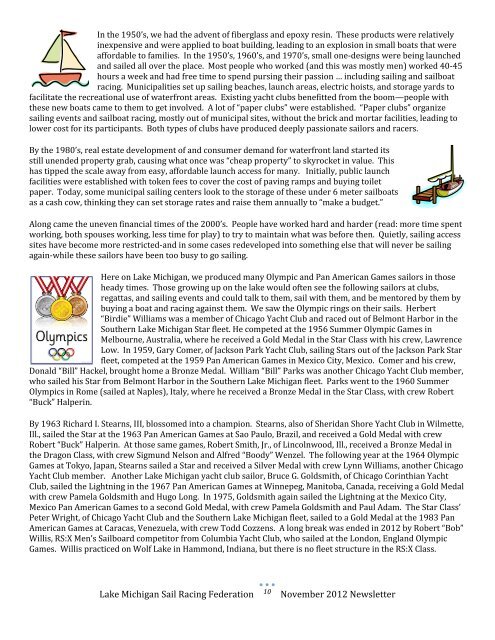Lake Michigan SuRF Newsletter - LMSRF
Lake Michigan SuRF Newsletter - LMSRF
Lake Michigan SuRF Newsletter - LMSRF
You also want an ePaper? Increase the reach of your titles
YUMPU automatically turns print PDFs into web optimized ePapers that Google loves.
In the 1950’s, we had the advent of fiberglass and epoxy resin. These products were relatively<br />
inexpensive and were applied to boat building, leading to an explosion in small boats that were<br />
affordable to families. In the 1950’s, 1960’s, and 1970’s, small one-designs were being launched<br />
and sailed all over the place. Most people who worked (and this was mostly men) worked 40-45<br />
hours a week and had free time to spend pursing their passion … including sailing and sailboat<br />
racing. Municipalities set up sailing beaches, launch areas, electric hoists, and storage yards to<br />
facilitate the recreational use of waterfront areas. Existing yacht clubs benefitted from the boom—people with<br />
these new boats came to them to get involved. A lot of “paper clubs” were established. “Paper clubs” organize<br />
sailing events and sailboat racing, mostly out of municipal sites, without the brick and mortar facilities, leading to<br />
lower cost for its participants. Both types of clubs have produced deeply passionate sailors and racers.<br />
By the 1980’s, real estate development of and consumer demand for waterfront land started its<br />
still unended property grab, causing what once was “cheap property” to skyrocket in value. This<br />
has tipped the scale away from easy, affordable launch access for many. Initially, public launch<br />
facilities were established with token fees to cover the cost of paving ramps and buying toilet<br />
paper. Today, some municipal sailing centers look to the storage of these under 6 meter sailboats<br />
as a cash cow, thinking they can set storage rates and raise them annually to “make a budget.”<br />
Along came the uneven financial times of the 2000’s. People have worked hard and harder (read: more time spent<br />
working, both spouses working, less time for play) to try to maintain what was before then. Quietly, sailing access<br />
sites have become more restricted-and in some cases redeveloped into something else that will never be sailing<br />
again-while these sailors have been too busy to go sailing.<br />
Here on <strong>Lake</strong> <strong>Michigan</strong>, we produced many Olympic and Pan American Games sailors in those<br />
heady times. Those growing up on the lake would often see the following sailors at clubs,<br />
regattas, and sailing events and could talk to them, sail with them, and be mentored by them by<br />
buying a boat and racing against them. We saw the Olympic rings on their sails. Herbert<br />
“Birdie” Williams was a member of Chicago Yacht Club and raced out of Belmont Harbor in the<br />
Southern <strong>Lake</strong> <strong>Michigan</strong> Star fleet. He competed at the 1956 Summer Olympic Games in<br />
Melbourne, Australia, where he received a Gold Medal in the Star Class with his crew, Lawrence<br />
Low. In 1959, Gary Comer, of Jackson Park Yacht Club, sailing Stars out of the Jackson Park Star<br />
fleet, competed at the 1959 Pan American Games in Mexico City, Mexico. Comer and his crew,<br />
Donald “Bill” Hackel, brought home a Bronze Medal. William “Bill” Parks was another Chicago Yacht Club member,<br />
who sailed his Star from Belmont Harbor in the Southern <strong>Lake</strong> <strong>Michigan</strong> fleet. Parks went to the 1960 Summer<br />
Olympics in Rome (sailed at Naples), Italy, where he received a Bronze Medal in the Star Class, with crew Robert<br />
“Buck” Halperin.<br />
By 1963 Richard I. Stearns, III, blossomed into a champion. Stearns, also of Sheridan Shore Yacht Club in Wilmette,<br />
Ill., sailed the Star at the 1963 Pan American Games at Sao Paulo, Brazil, and received a Gold Medal with crew<br />
Robert “Buck” Halperin. At those same games, Robert Smith, Jr., of Lincolnwood, Ill., received a Bronze Medal in<br />
the Dragon Class, with crew Sigmund Nelson and Alfred “Boody” Wenzel. The following year at the 1964 Olympic<br />
Games at Tokyo, Japan, Stearns sailed a Star and received a Silver Medal with crew Lynn Williams, another Chicago<br />
Yacht Club member. Another <strong>Lake</strong> <strong>Michigan</strong> yacht club sailor, Bruce G. Goldsmith, of Chicago Corinthian Yacht<br />
Club, sailed the Lightning in the 1967 Pan American Games at Winnepeg, Manitoba, Canada, receiving a Gold Medal<br />
with crew Pamela Goldsmith and Hugo Long. In 1975, Goldsmith again sailed the Lightning at the Mexico City,<br />
Mexico Pan American Games to a second Gold Medal, with crew Pamela Goldsmith and Paul Adam. The Star Class’<br />
Peter Wright, of Chicago Yacht Club and the Southern <strong>Lake</strong> <strong>Michigan</strong> fleet, sailed to a Gold Medal at the 1983 Pan<br />
American Games at Caracas, Venezuela, with crew Todd Cozzens. A long break was ended in 2012 by Robert “Bob”<br />
Willis, RS:X Men’s Sailboard competitor from Columbia Yacht Club, who sailed at the London, England Olympic<br />
Games. Willis practiced on Wolf <strong>Lake</strong> in Hammond, Indiana, but there is no fleet structure in the RS:X Class.<br />
<strong>Lake</strong> <strong>Michigan</strong> Sail Racing Federation 10 November 2012 <strong>Newsletter</strong>


